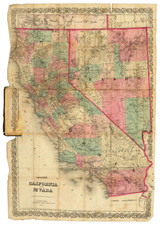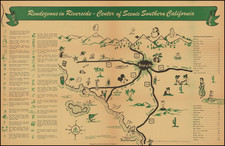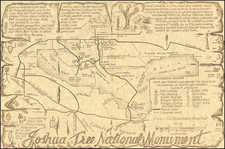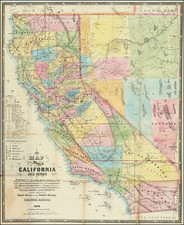Drawn By One of The Most Famous Early Disney Illustrators
Whimsical map of the Virginia & Truckee Railroad, published by the California-Nevada Railroad Historical Society to commemorate the Society's chartering a train to make the excursion east to Virginia. City.
A marvelous map, extending from Lake Tahoe to Reno, Carson City and Virginia City, filled with clever illustrations and other references.
The map is an example of the work of Disney animator Ward Kimball. Ward Kimball was one of Walt Disney's top animators in the 1940s and 50s, working on Pinocchio, Dumbo, Alice in Wonderland, Peter Pan, and many other films. But he was also a huge railroad buff, as were most of the Disney folks, including Walt himself. But Ward was the biggest railfan of the bunch, even building a full-size railroad in his own backyard (Grizzly Flats Railroad), an idea which Walt copied for his own house.
Ward Kimball also used to love coming to Carson City, because back in the 1940s the Virginia & Truckee Railroad was still running. He would make the drive up from LA, ride the train, and take tons of pictures. During an excursion in 1941 he drew this map of the Virginia & Truckee route, which is illustrated in the book Bonanza Road.
Ward Kimball
Ward Kimball (1914-2002) was one of a group of illustrators known as Disney's Nine Old Men.
Born in Minneapolis, Kimball attended the Santa Barbara School of the Arts in order to become a painter and illustrator. Kimball's instructor at the school suggested to him that his work should be submitted to Walt Disney Productions (later known as the Walt Disney Animation Studios), and that he should pursue a career in animation. In March 1934, a 20-year-old Kimball applied for a job at the Disney studio and was hired as an inbetweener. He was then promoted to an assistant animator. He served as an assistant to animator Hamilton Luske. Kimball worked primarily in the Silly Symphony series, where his film credits include the animated short films The Wise Little Hen (1934), The Goddess of Spring (1934), and The Tortoise and the Hare (1935). He also worked on the Mickey Mouse series, where his film credits include the short film Orphan's Benefit (1934).
In 1936, Kimball was promoted to an animator. He continued to work in the Silly Symphony series. Some of his memorable credits in this position include the animated short films Toby Tortoise Returns (1936), More Kittens (1936), an d Mother Goose Goes Hollywood (1938). His first solo effort as an animator was animating a grasshopper turned musician in Woodland Café (1937).
Kimball was included in the team of animators known later as Disney's Nine Old Men, whose original task was animating Snow White and the Seven Dwarfs (1937). The film was the first full-length animated feature film by the Disney studio. Kimball spent months working on the sequence animation for a scene where the Seven Dwarfs are eating soup, prepared for them by Snow White.
Following the release of Snow White, Kimball was promoted to a supervising or directing animator. He would remain in this position until his retirement in the 1970s. His employer Walt Disney was sufficiently satisfied with Kimball's work that he entrusted him with designing a new character Jiminy Cricket. The character was intended for use in the Disney studio's next feature film, Pinocchio. It took Kimball 12 or 14 drafts before completing his final design of Jiminy. Kimball told one interviewer that he "hated" animating Jiminy Cricket: "I got sick of drawing that oval head looking in every direction." Kimball's next major task was designing the sympathetic Crows in Dumbo (1941). Following the example of the Seven Dwarfs from Snow White, Kimball had to give each crow a distinct appearance and character.
Kimball supervised or directed the animation of several Disney animated feature films. Among them were Fantasia (1940), The Reluctant Dragon (1941), and The Three Caballeros (1944). The last film mentioned featured the trio of Donald Duck, José Carioca, and Panchito Pistoles
Kimball directed the character animation and sequences of the Pecos Bill segment in Melody Time (1948). He also worked as a senior animator for The Adventures of Ichabod and Mr. Toad (1949). In Cinderella (1950), Kimball was responsible for the characters Jaq and Gus and Lucifer the Cat. In Alice in Wonderland (1951), Kimball was responsible for Tweedledee and Tweedledum, the Walrus and the Carpenter, the Hatter and his mad tea party, and the Cheshire Cat. His other film credits include the feature films Peter Pan (1953), Mary Poppins (1964), and Bedknobs and Broomsticks (1971).
Kimball spent much of his career animating theatrical animated short films. However, he also served as a director for some of them. He and Charles August Nichols co-directed the animated short films Melody (1953) and Toot, Whistle, Plunk and Boom (1953) which won the 1954 Academy Award for Best Animated Short Film. Melody was the Disney studio's first animated 3D film Toot, Whistle, Plunk and Boom won the Academy Award for Best Animated Short Film. It was the Disney studio's first widescreen CinemaScope animated film.
Kimball also directed the short films It's T ough to Be a Bird (1969) and Dad, Can I Borrow the Car? (1970). It's Tough to Be a Bird won the Academy Award for Best Animated Short Film.
Kimball served as a screenwriter for the featurette Eyes In Outer Space (1959). The film combined live action and animation. It depicted weather satellites and explained how the weather is predicted. The film was originally theatrically released. Around 1962, it started being shown in Disneyland.
During the 1950s, the Disney studio shifted its focus from theatrical animation to television. Kimball wrote and directed three hour-long television shows about space exploration. They were Man in Space (1955), Man and the Moon (1955), and Mars and Beyond (1957). The consultants for these shows included pioneers of the Space Age, such as aerospace engineer Wernher von Braun. According to animation historian Jeff Lenburg, the three shows helped in sparking popular interest in spaceflight. Kimball was also responsible for the science-fiction two-reel cartoon Cosmic Capers (1957).
Kimball also worked (as a writer) on the live-action film Babes in Toyland (1961), a musical film. He later returned to television and directed 43 episodes of T he Mouse Factory (1972-1973).
It is likely that this map was made by Kimball because of his love of trains. Kimball was profiled by producer Jerry Fairbanks in his Paramount Pictures film short series Unusual Occupations. This 35mm Magnacolor film short was released theatrically in 1944; it focused on Kimball's backyard railroad and full-sized locomotive.
Kimball was also a jazz trombonist. He founded and led the seven-piece Dixieland band Firehouse Five Plus Two, in which he played trombone. The band made at least 13 LP records and toured clubs, college campuses and jazz festivals from the 1940s to early 1970s.
Kimball also produced two editions of a volume titled Art Afterpieces, in which he revised various well-known works of art, such as putting Mona Lisa's hair up in curlers, showing Whistler's Mother watching TV, and adding a Communist flag and Russian boots to Pinkie. These masterpiece remixes are thought to have been appropriated by the street artist Banksy.
Rarity
This is the first time we have ever seen this map.









![(Mexican War) [ Proposed United States - Mexico Military Border - January 1848 ]](https://storage.googleapis.com/raremaps/img/small/99246.jpg)

![Air Log Western Air Express [Los Angeles-San Diego, Las Vegas-Los Angeles, Milford-Vegas, Salt Lake City-Milford]](https://storage.googleapis.com/raremaps/img/small/85953.jpg)


